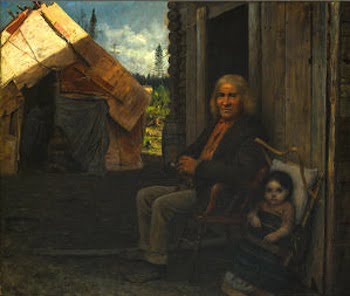Sotheby’s London sale of Victorian and Edwardian Art on Thursday, 13th July 2010, will present two paintings that provide a fascinating glimpse into Victorian life as it would have been experienced by London residents at the time. Populated by a cross section of classes in the social spectrum, the pictures chart the onslaught and speed of the encroaching modern world. Bank and the Royal Exchange by William Logsdail (1859?-1944), estimated at £600,000-800,000, and Infant Orphan Election at the London Tavern – Polling, by George Elgar Hicks (1824-1914), estimated at £500,000-700,000, were both exhibited at the Royal Academy and well received by art critics of the day.

Bank and the Royal Exchange by William Logsdail. Estimate: £600,000-800,000. Photo: Sotheby’s
Logsdail’s Bank and the Royal Exchange was painted in 1887, one of a series of London street scenes for which he is now best known. The artist set up his easel between the Corinthian columns of the portico of Mansion House; this afforded him a high vantage point above the junction of Cornhill and Cheapside. The elevated position placed Logsdail on the same level as the tops of buses and he had to endure abusive behaviour from the passengers and drivers of the vehicles. The city’s metropolitan bustle and noise, from the cacophony of the clatter of horses hooves and the wheels of the carriages, was recounted by the artist in an amusing recollection many years later, as he reminisced about the unrelenting cries of the conductors: “Strend, Charing Crawss, Picadilly, ere yar, sibishun, jamp in there…” This experience must have stood in sharp contrast to the artist’s previous sojourn in Venice, where he had noted the convivial nature of the passers-by who appreciated his endeavours and behaved in an understanding, sympathetic and friendly manner.
Logsdail’s picture shows the various commercial and passenger traffic, from the two?wheeled hansoms with their frilled canopies to the crowded omnibuses bearing product advertisements. Despite the grandeur of the setting and its associations with prosperity and Empire, Logsdail did not shy away from depicting the hardships of the urban poor, whose slum dwellings bordered the financial heart of London. A child-beggar clutching a baby and being reprimanded by a policeman is looked upon with concern by a fashionable young woman accompanied by her Pomeranian dog.
For the quadrant outside his Primrose Hill studio, Logsdail commissioned a local carpenter to make a model of the top deck of a bus where his sitters could pose in relative comfort. Drafted into the esteemed group were the artist John William Waterhouse (on the extreme left, wearing a top hat), Waterhouse’s wife Esther, Waterhouse’s half-sister Mary, Logsdail’s fellow artist and neighbour William Peregrine Feeney, Waterhouse’s sister?in?law Miss Emily Kenworthy, the venerable animal painter Joseph Wolf, the portrait painter Lance Calkin, the watercolour painter Tom Lloyd, and Frederick Villiers, the war correspondent.
George Elgar Hick’s The Infant Orphan Election at the London Tavern – Polling depicts the plight of the urban poor as a ballot is taken to determine which of the city’s needy children receive aid. Painted in 1865, it portrayed a method of selection that was already regarded as unsatisfactory in the 1860s, and a system that was almost entirely swept away by the early years of the following decade. Children were elected by ballot to the Wanstead Orphan Asylum, founded in 1841 as a beneficient scheme to relieve the destitution of the city’s urban poor. They were all from middle-class or professional families who had fallen on hard times. The cost of board and education was covered by subscriptions from charitable, better?off members of the public, and these payments entitled them to vote for children who they felt were the most deserving. Hicks records the indignity of such a parade with his customary attention to detail, and the interior is strewn with placards for real life applicants. The London Tavern in Bishopsgate was closed in 1876 and the new purchaser of the site, the Bank of Scotland, demolished the building.
Careful observation of both Logsdail’s painting and the present work rewards the viewer with a myriad of human details and gestures, from the delivery boy attempting to cross the road with a crate in the city street, to the array of figures captured by Hicks: the anguished impoverished woman, the pompous officials, the little children playing happily in the crowd, and the aged man in a silk top?hat who wipes the lenses of his glasses in a brief respite from the surrounding chaos. A sense of modern life in contemporary London unites these works and both are a fitting testimony to the urban bustle of the city, as played out on the street and behind closed doors.



